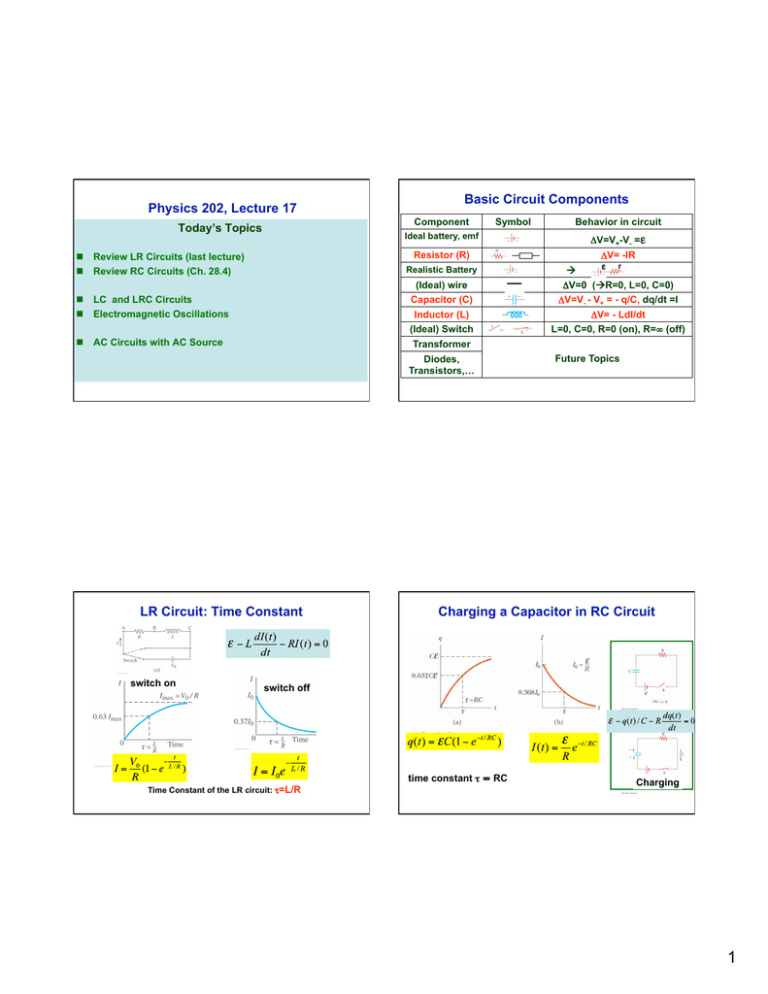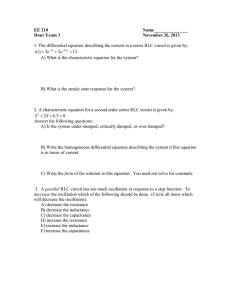Physics 202, Lecture 17 Basic Circuit Components LR Circuit: Time
advertisement

Physics 202, Lecture 17 Component Today’s Topics Symbol Behavior in circuit Ideal battery, emf ΔV=V+-V- =ε Resistor (R) Review LR Circuits (last lecture) Review RC Circuits (Ch. 28.4) Realistic Battery LC and LRC Circuits Electromagnetic Oscillations AC Circuits with AC Source ΔV= -IR ε r (Ideal) wire Capacitor (C) ΔV=0 (R=0, L=0, C=0) ΔV=V- - V+ = - q/C, dq/dt =I Inductor (L) (Ideal) Switch ΔV= - LdI/dt L=0, C=0, R=0 (on), R=∞ (off) Transformer Diodes, Transistors,… LR Circuit: Time Constant switch on Basic Circuit Components Future Topics Charging a Capacitor in RC Circuit switch off time constant τ Time Constant of the LR circuit: τ=L/R = RC Charging 1 Discharging a Capacitor in RC Circuit Another look at the currents In a capacitor: charging: current I decreases discharging: current in opposite direction, |I| decreases For t=∞ , Either ways, I vanishes ! In an inductor: switching on: current I increases switching off: current I decreases, same direction In a resistor: switching on and off: current I instantaneous, steady. Again the time constant τ=RC discharging LC Circuit and Oscillation Find the oscillation frequency of a LC circuit LC Circuit and Oscillation: Potential View Find the potential across C , L ΔVC I ΔVL eq. of Harmonic Oscillation Across C: ΔVC= -Q/C=-(Qmax/C) cos(ωt+φ) Across L: ΔVL =-LdI/dt = Lω2Qmax cos(ωt+φ) =+(Qmax/C) cos(ωt+φ) =-(Qmax/C) cos(ωt+φ+180ο) | ΔVC| = |ΔVC| but with an 180o phase difference. This is an oscillation between L and C. 2 LC Circuit and Oscillation: Energy View Find the energies stored in C, L in C: UC= ½ Q2/C = ½ (Qmax2/C) cos2(ωt+φ) in L: UL= ½ LI2 = ½ Lω2 Qmax2 sin2(ωt+φ) = ½ (Qmax2/C) sin2(ωt+φ) Total energy: U= UL+UC = ½ (Qmax2/C) = constant! No energy is lost in a pure LC oscillator. LC Oscillation with Resistor: LRC Circuit Oscillation frequency of a LRC circuit Solution: Q(t) = Qmax e –Rt/2L cosω t U=UC+UL Next: What about adding an R? LRC Circuit: Damped Oscillation C: overdamped “oscillation” ω’: effective frequency with damping eq. of Harmonic Oscillation with damping AC Power Source ΔV = ΔVmax Sin(ωt+φ0) = ΔVmax Sin(ωt) Initial phase, usually set φ0=0 ω: angular frequency ω=2πf T=2π/ω B: critically damped oscillation t=0 A: underdamped oscillation recall: T=1/f 3 AC Circuit i ΔVmax Sin(ωt) A sinusoidal function x= Asinφ can be represented graphically as a phasor vector with length A and angle φ (w.r.t. to horizontal) Asinφ Find out current i and voltage difference ΔVR, ΔVL, ΔVC. Phasor A φ • Kirchhoff’s rules still apply solving differential eqs! • A technique called phasor analysis is convenient. Solution will be given in next lecture Please preview Ch 33 before next lecture 4



